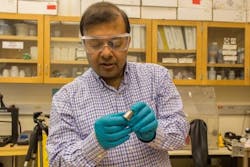Multimaterial 3D printing is shown to be achievable in one step
A team of researchers at Washington State University (Pullman, WA) used 3D printing technology in a one-step process to print structures made of two different materials. The advance could potentially help manufacturers reduce manufacturing steps and use one machine to make complex products with multiple parts in one operation.
Related: Selecting and using materials for additive manufacturing processes
Led by Amit Bandyopadhyay, Herman and Brita Lindholm Endowed Chair Professor in the School of Mechanical and Materials Engineering, the researchers used 3D printing technology to print out metal and ceramic structures as well as a bimetallic tube that is magnetic in one end and nonmagnetic in the other. By being able to use more than one material at a time, they will be able to better control properties like heat conduction, corrosion protection, as well as environmental adaptation in their materials.
Amit Bandyopadhyay shows a 3D-printed bimetallic sample.
With adoption of multimaterial 3D printing, manufacturers also won't need to use the adhesives or joint connections that are now required for creating multimaterial products. "You could be joining two very strong materials together, but their connection will only be as strong as their adhesive," Bandyopadhyay explains. "Multimaterial additive manufacturing helps get rid of the weak point."
The researchers, including graduate students Bryan Heer and Bonny Onuike, used a laser-based 3D printer to join the materials in a single step, printing out a nickel-chromium and copper structure. Inconel 718 is a nickel-chromium alloy used in liquid-fueled rockets and for sheet metal parts for airplane engines. The material is able to withstand high temperatures well, but it cools very slowly. When the researchers added the copper in the 3D printing process, the part could be cooled 250% faster, meaning a longer life and higher fuel efficiency for airplane engines.
Working with graduate students Tom Gualtieri and Yanning Zhang, the researchers also printed metal-ceramic material in one operation.
Full details of the work appear in the journal Additive Manufacturing.

